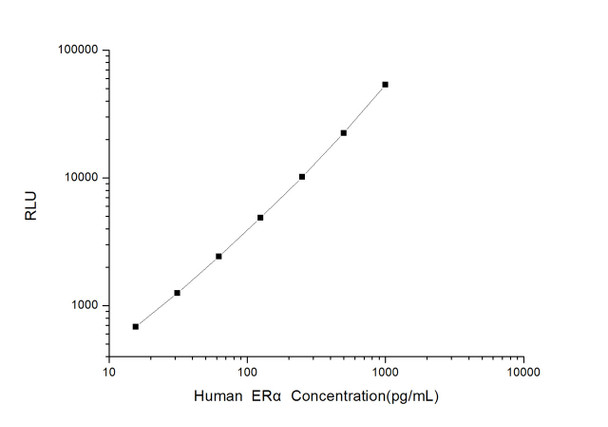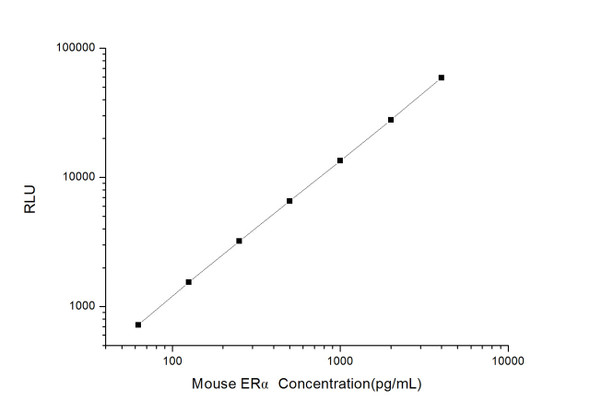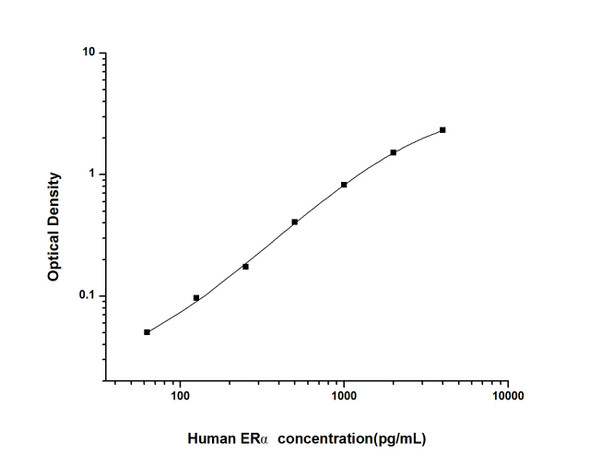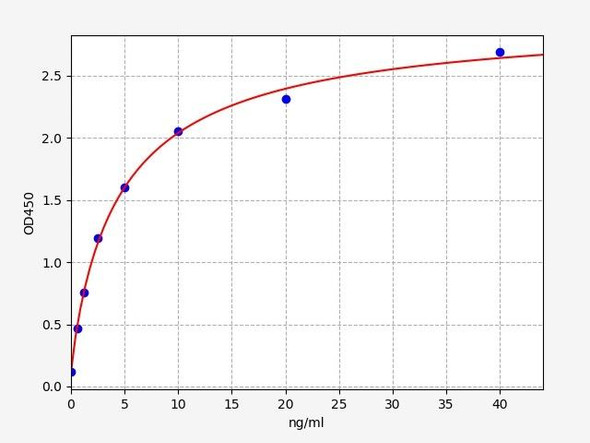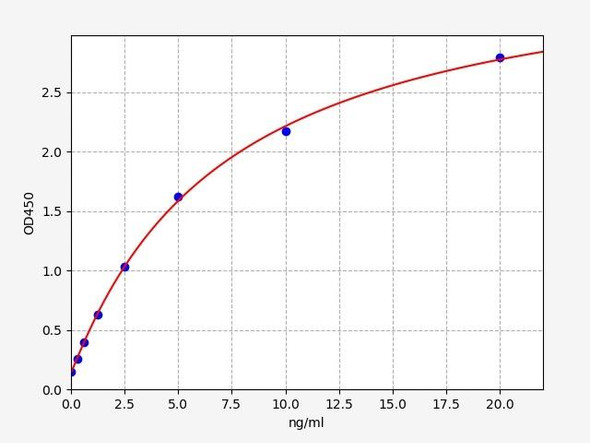Human Epigenetics and Nuclear Signaling ELISA Kits
Human ER alpha (Estrogen Receptor Alpha) CLIA Kit (HUES00662)
- SKU:
- HUES00662
- Product Type:
- ELISA Kit
- ELISA Type:
- CLIA Kit
- Size:
- 96 Assays
- Sensitivity:
- 9.38pg/mL
- Range:
- 15.63-1000pg/mL
- ELISA Type:
- Sandwich
- Synonyms:
- ESR1, ER, ESR, ESRA, Era, NR3A1, nuclear receptor subfamily 3, group A, member 1
- Reactivity:
- Human
- Sample Type:
- Serum, plasma and other biological fluids
- Research Area:
- Epigenetics and Nuclear Signaling
Description
| Assay type: | Sandwich |
| Format: | 96T |
| Assay time: | 4.5h |
| Reactivity: | Human |
| Detection method: | Chemiluminescence |
| Detection range: | 15.63-1000 pg/mL |
| Sensitivity: | 9.38 pg/mL |
| Sample volume: | 100µL |
| Sample type: | Tissue homogenates,cell lysates and other biological fluids |
| Repeatability: | CV < 15% |
| Specificity: | This kit recognizes Human ER alpha in samples. No significant cross-reactivity or interference between Human ER alpha and analogues was observed. |
This kit uses Sandwich-CLIA as the method. The micro CLIA plate provided in this kit has been pre-coated with an antibody specific to Human ER alpha. Standards or samples are added to the appropriate micro CLIA plate wells and combined with the specific antibody. Then a biotinylated detection antibody specific for Human ER alpha and Avidin-Horseradish Peroxidase (HRP) conjugate are added to each micro plate well successively and incubated. Free components are washed away. The substrate solution is added to each well. Only those wells that contain Human ER alpha, biotinylated detection antibody and Avidin-HRP conjugate will appear fluorescence. The Relative light unit (RLU) value is measured spectrophotometrically by the Chemiluminescence immunoassay analyzer. The RLU value is positively associated with the concentration of Human ER alpha. The concentration of Human ER alpha in the samples can be calculated by comparing the RLU of the samples to the standard curve.
| UniProt Protein Function: | Function: Nuclear hormone receptor. The steroid hormones and their receptors are involved in the regulation of eukaryotic gene expression and affect cellular proliferation and differentiation in target tissues. Ligand-dependent nuclear transactivation involves either direct homodimer binding to a palindromic estrogen response element (ERE) sequence or association with other DNA-binding transcription factors, such as AP-1/c-Jun, c-Fos, ATF-2, Sp1 and Sp3, to mediate ERE-independent signaling. Ligand binding induces a conformational change allowing subsequent or combinatorial association with multiprotein coactivator complexes through LXXLL motifs of their respective components. Mutual transrepression occurs between the estrogen receptor (ER) and NF-kappa-B in a cell-type specific manner. Decreases NF-kappa-B DNA-binding activity and inhibits NF-kappa-B-mediated transcription from the IL6 promoter and displace RELA/p65 and associated coregulators from the promoter. Recruited to the NF-kappa-B response element of the CCL2 and IL8 promoters and can displace CREBBP. Present with NF-kappa-B components RELA/p65 and NFKB1/p50 on ERE sequences. Can also act synergistically with NF-kappa-B to activate transcription involving respective recruitment adjacent response elements; the function involves CREBBP. Can activate the transcriptional activity of TFF1. Also mediates membrane-initiated estrogen signaling involving various kinase cascades. Isoform 3 is involved in activation of NOS3 and endothelial nitric oxide production. Isoforms lacking one or several functional domains are thought to modulate transcriptional activity by competitive ligand or DNA binding and/or heterodimerization with the full length receptor. Isoform 3 can bind to ERE and inhibit isoform 1. Ref. 17 Ref. 19 Ref. 24 Ref. 30 Ref. 31 Ref. 33 Ref. 36 Ref. 44 Ref. 46 Ref. 47 Ref. 48 Ref. 52 Ref. 63 Ref. 65 Ref. 70 Ref. 75 Ref. 77 Ref. 78 Ref. 80 |
| UniProt Protein Details: | Subunit structure: Binds DNA as a homodimer. Can form a heterodimer with ESR2. Isoform 3 can probably homodimerize or heterodimerize with isoform 1 and ESR2. Interacts with FOXC2, MAP1S, SLC30A9, UBE1C and NCOA3 coactivator By similarity. Interacts with EP300; the interaction is estrogen-dependent and enhanced by CITED1. Interacts with CITED1; the interaction is estrogen-dependent. Interacts with NCOA5 and NCOA6 coactivators. Interacts with NCOA7; the interaction is a ligand-inducible. Interacts with PHB2, PELP1 and UBE1C. Interacts with AKAP13. Interacts with CUEDC2. Interacts with KDM5A. Interacts with SMARD1. Interacts with HEXIM1. Interacts with PBXIP1. Interaction with MUC1 is stimulated by 7 beta-estradiol (E2) and enhances ERS1-mediated transcription. Interacts with DNTTIP2, FAM120B and UIMC1. Interacts with isoform 4 of TXNRD1. Interacts with KMT2D/MLL2. Interacts with ATAD2 and this interaction is enhanced by estradiol. Interacts with KIF18A and LDB1. Interacts with RLIM (via C-terminus). Interacts with MACROD1. Interacts with SH2D4A and PLCG. Interaction with SH2D4A blocks binding to PLCG and inhibits estrogen-induced cell proliferation. Interacts with DYNLL1. Interacts with CCDC62 in the presence of estradiol/E2; this interaction seems to enhance the transcription of target genes. Interacts with NR2C1; the interaction prevents homodimerization of ESR1 and suppresses its transcriptional activity and cell growth. Interacts with DYX1C1. Interacts with PRMT2. Interacts with PI3KR1 or PI3KR2, SRC and PTK2/FAK1. Interacts with RBFOX2. Interacts with STK3/MST2 only in the presence of SAV1 and vice-versa. Binds to CSNK1D. Interacts with NCOA2; NCOA2 can interact with ESE1 AF-1 and AF-2 domains simultaneously and mediate their transcriptional synergy. Interacts with DDX5. Interacts with NCOA1; the interaction seems to require a self-association of N-terminal and C-terminal regions. Interacts with ZNF366, DDX17, NFKB1, RELA, SP1 and SP3. Interacts with NRIP1 By similarity. Interacts with GPER1; the interaction occurs in an estrogen-dependent manner. Ref. 18 Ref. 19 Ref. 21 Ref. 24 Ref. 25 Ref. 27 Ref. 28 Ref. 29 Ref. 30 Ref. 31 Ref. 32 Ref. 33 Ref. 34 Ref. 35 Ref. 36 Ref. 37 Ref. 38 Ref. 39 Ref. 40 Ref. 41 Ref. 42 Ref. 43 Ref. 45 Ref. 48 Ref. 50 Ref. 51 Ref. 53 Ref. 54 Ref. 55 Ref. 56 Ref. 57 Ref. 58 Ref. 59 Ref. 60 Ref. 61 Ref. 62 Ref. 64 Ref. 65 Ref. 66 Ref. 67 Ref. 68 Ref. 69 Ref. 70 Ref. 71 Ref. 72 Ref. 73 Ref. 74 Ref. 76 Ref. 91 Subcellular location: Isoform 1: Nucleus. Cytoplasm. Cell membrane; Peripheral membrane protein; Cytoplasmic side. Note: A minor fraction is associated with the inner membrane. Ref. 6 Ref. 22 Ref. 48 Ref. 59 Ref. 64 Ref. 77 Ref. 79Isoform 3: Nucleus. Cytoplasm. Cell membrane; Peripheral membrane protein; Cytoplasmic side. Cell membrane; Single-pass type I membrane protein. Note: Associated with the inner membrane via palmitoylation Probable. At least a subset exists as a transmembrane protein with a N-terminal extracellular domain. Ref. 6 Ref. 22 Ref. 48 Ref. 59 Ref. 64 Ref. 77 Ref. 79Nucleus. Golgi apparatus. Cell membrane. Note: Colocalizes with ZDHHC7 and ZDHHC21 in the Golgi apparatus where most probably palmitoylation occurs. Associated with the plasma membrane when palmitoylated. Ref. 6 Ref. 22 Ref. 48 Ref. 59 Ref. 64 Ref. 77 Ref. 79 Tissue specificity: Widely expressed. Isoform 3 is not expressed in the pituitary gland. Ref. 19 Domain: Composed of three domains: a modulating N-terminal domain, a DNA-binding domain and a C-terminal ligand-binding domain. The modulating domain, also known as A/B or AF-1 domain has a ligand-independent transactivation function. The C-terminus contains a ligand-dependent transactivation domain, also known as E/F or AF-2 domain which overlaps with the ligand binding domain. AF-1 and AF-2 activate transcription independently and synergistically and act in a promoter- and cell-specific manner. AF-1 seems to provide the major transactivation function in differentiated cells. Post-translational modification: Phosphorylated by cyclin A/CDK2 and CK1. Phosphorylation probably enhances transcriptional activity. Self-association induces phosphorylation. Dephosphorylation at Ser-118 by PPP5C inhibits its transactivation activity. Ref. 10 Ref. 14 Ref. 16 Ref. 26 Ref. 46 Ref. 72Glycosylated; contains N-acetylglucosamine, probably O-linked. Ref. 23Ubiquitinated. Deubiquitinated by OTUB1. Ref. 71Dimethylated by PRMT1 at Arg-260. The methylation may favor cytoplasmic localization. Ref. 64Palmitoylated (isoform 3) Not biotinylated (isoform 3) Ref. 22 Ref. 79Palmitoylated by ZDHHC7 and ZDHHC21. Palmitoylation is required for plasma membrane targeting and for rapid intracellular signaling via ERK and AKT kinases and cAMP generation, but not for signaling mediated by the nuclear hormone receptor. Ref. 22 Ref. 79 Polymorphism: Genetic variations in ESR1 are correlated with bone mineral density (BMD). Low BMD is a risk factor for osteoporotic fracture. Osteoporosis is characterized by reduced bone mineral density, disrutption of bone microarchitecture, and the alteration of the amount and variety of non-collagenous proteins in bone. Osteoporotic bones are more at risk of fracture. Involvement in Disease: Estrogen resistance (ESTRR) [MIM:615363]: A disorder characterized by partial or complete resistance to estrogens, in the presence of elevated estrogen serum levels. Clinical features include absence of the pubertal growth spurt, delayed bone maturation, unfused epiphyses, reduced bone mineral density, osteoporosis, continued growth into adulthood and very tall adult stature. Glucose intolerance, hyperinsulinemia and lipid abnormalities may also be present. Note: The disease is caused by mutations affecting the gene represented in this entry. Ref. 88 Ref. 93 Miscellaneous: Selective estrogen receptor modulators (SERMs), such as tamoxifen, raloxifene, toremifene, lasofoxifene, clomifene, femarelle and ormeloxifene, have tissue selective agonistic and antagonistic effects on the estrogen receptor (ER). They interfere with the ER association with coactivators or corepressors, mainly involving the AF-2 domain. Sequence similarities: Belongs to the nuclear hormone receptor family. NR3 subfamily. Contains 1 nuclear receptor DNA-binding domain. |
| NCBI Summary: | This gene encodes an estrogen receptor, a ligand-activated transcription factor composed of several domains important for hormone binding, DNA binding, and activation of transcription. The protein localizes to the nucleus where it may form a homodimer or a heterodimer with estrogen receptor 2. Estrogen and its receptors are essential for sexual development and reproductive function, but also play a role in other tissues such as bone. Estrogen receptors are also involved in pathological processes including breast cancer, endometrial cancer, and osteoporosis. Alternative splicing results in several transcript variants, which differ in their 5' UTRs and use different promoters. [provided by RefSeq, Jul 2008] |
| UniProt Code: | P03372 |
| NCBI GenInfo Identifier: | 544257 |
| NCBI Gene ID: | 2099 |
| NCBI Accession: | P03372. 2 |
| UniProt Secondary Accession: | P03372,Q13511, Q14276, Q5T5H7, Q6MZQ9, Q9NU51, Q9UDZ7 Q9UIS7, |
| UniProt Related Accession: | P03372 |
| Molecular Weight: | |
| NCBI Full Name: | Estrogen receptor |
| NCBI Synonym Full Names: | estrogen receptor 1 |
| NCBI Official Symbol: | ESR1 |
| NCBI Official Synonym Symbols: | ER; ESR; Era; ESRA; ESTRR; NR3A1 |
| NCBI Protein Information: | estrogen receptor; ER-alpha; estradiol receptor; estrogen nuclear receptor alpha; estrogen receptor alpha E1-E2-1-2; estrogen receptor alpha E1-N2-E2-1-2; estrogen receptor alpha delta 4 +49 isoform; nuclear receptor subfamily 3 group A member 1; estrogen receptor alpha 3*,4,5,6,7*/822 isoform; estrogen receptor alpha delta 4*,5,6,7*/654 isoform; estrogen receptor alpha delta 4*,5,6,7,8*/901 isoform; estrogen receptor alpha delta 3*,4,5,6,7*/819-2 isoform; estrogen receptor alpha delta 3*,4,5,6,7*,8*/941 isoform |
| UniProt Protein Name: | Estrogen receptor |
| UniProt Synonym Protein Names: | ER-alpha; Estradiol receptor; Nuclear receptor subfamily 3 group A member 1 |
| Protein Family: | Erbin |
| UniProt Gene Name: | ESR1 |
| UniProt Entry Name: | ESR1_HUMAN |
As the RLU values of the standard curve may vary according to the conditions of the actual assay performance (e. g. operator, pipetting technique, washing technique or temperature effects), the operator should establish a standard curve for each test. Typical standard curve and data is provided below for reference only.
| Concentration (pg/mL) | RLU | Average | Corrected |
| 1000 | 49287 58063 | 53675 | 53650 |
| 500 | 22074 22904 | 22489 | 22464 |
| 250 | 10447 9975 | 10211 | 10186 |
| 125 | 4491 5311 | 4901 | 4876 |
| 62.5 | 2645 2261 | 2453 | 2428 |
| 31.25 | 1351 1211 | 1281 | 1256 |
| 15.63 | 670 746 | 708 | 683 |
| 0 | 24 26 | 25 | -- |
Precision
Intra-assay Precision (Precision within an assay): 3 samples with low, mid range and high level Human ER alpha were tested 20 times on one plate, respectively.
Inter-assay Precision (Precision between assays): 3 samples with low, mid range and high level Human ER alpha were tested on 3 different plates, 20 replicates in each plate.
| Intra-assay Precision | Inter-assay Precision | |||||
| Sample | 1 | 2 | 3 | 1 | 2 | 3 |
| n | 20 | 20 | 20 | 20 | 20 | 20 |
| Mean (pg/mL) | 45.58 | 84.75 | 444.05 | 48.27 | 81.15 | 406.26 |
| Standard deviation | 5.16 | 7.44 | 38.01 | 5.24 | 9.22 | 30.39 |
| C V (%) | 11.32 | 8.78 | 8.56 | 10.86 | 11.36 | 7.48 |
Recovery
The recovery of Human ER alpha spiked at three different levels in samples throughout the range of the assay was evaluated in various matrices.
| Sample Type | Range (%) | Average Recovery (%) |
| Serum (n=5) | 94-111 | 102 |
| EDTA plasma (n=5) | 100-112 | 106 |
| Cell culture media (n=5) | 84-95 | 90 |
Linearity
Samples were spiked with high concentrations of Human ER alpha and diluted with Reference Standard & Sample Diluent to produce samples with values within the range of the assay.
| Serum (n=5) | EDTA plasma (n=5) | Cell culture media (n=5) | ||
| 1:2 | Range (%) | 86-100 | 96-112 | 89-101 |
| Average (%) | 93 | 103 | 95 | |
| 1:4 | Range (%) | 101-119 | 96-111 | 102-116 |
| Average (%) | 110 | 103 | 108 | |
| 1:8 | Range (%) | 87-102 | 88-100 | 92-109 |
| Average (%) | 93 | 95 | 99 | |
| 1:16 | Range (%) | 96-109 | 84-99 | 91-104 |
| Average (%) | 103 | 91 | 98 |
An unopened kit can be stored at 4°C for 1 month. If the kit is not used within 1 month, store the items separately according to the following conditions once the kit is received.
| Item | Specifications | Storage |
| Micro CLIA Plate(Dismountable) | 8 wells ×12 strips | -20°C, 6 months |
| Reference Standard | 2 vials | |
| Concentrated Biotinylated Detection Ab (100×) | 1 vial, 120 µL | |
| Concentrated HRP Conjugate (100×) | 1 vial, 120 µL | -20°C(shading light), 6 months |
| Reference Standard & Sample Diluent | 1 vial, 20 mL | 4°C, 6 months |
| Biotinylated Detection Ab Diluent | 1 vial, 14 mL | |
| HRP Conjugate Diluent | 1 vial, 14 mL | |
| Concentrated Wash Buffer (25×) | 1 vial, 30 mL | |
| Substrate Reagent A | 1 vial, 5 mL | 4°C (shading light) |
| Substrate Reagent B | 1 vial, 5 mL | 4°C (shading light) |
| Plate Sealer | 5 pieces | |
| Product Description | 1 copy | |
| Certificate of Analysis | 1 copy |
- Set standard, test sample and control (zero) wells on the pre-coated plate and record theirpositions. It is recommended to measure each standard and sample in duplicate. Note: addall solutions to the bottom of the plate wells while avoiding contact with the well walls. Ensuresolutions do not foam when adding to the wells.
- Aliquot 100µl of standard solutions into the standard wells.
- Add 100µl of Sample / Standard dilution buffer into the control (zero) well.
- Add 100µl of properly diluted sample (serum, plasma, tissue homogenates and otherbiological fluids. ) into test sample wells.
- Cover the plate with the sealer provided in the kit and incubate for 90 min at 37°C.
- Aspirate the liquid from each well, do not wash. Immediately add 100µL of BiotinylatedDetection Ab working solution to each well. Cover the plate with a plate seal and gently mix. Incubate for 1 hour at 37°C.
- Aspirate or decant the solution from the plate and add 350µL of wash buffer to each welland incubate for 1-2 minutes at room temperature. Aspirate the solution from each well andclap the plate on absorbent filter paper to dry. Repeat this process 3 times. Note: a microplatewasher can be used in this step and other wash steps.
- Add 100µL of HRP Conjugate working solution to each well. Cover with a plate seal andincubate for 30 min at 37°C.
- Aspirate or decant the solution from each well. Repeat the wash process for five times asconducted in step 7.
- Add 100µL of Substrate mixture solution to each well. Cover with a new plate seal andincubate for no more than 5 min at 37°C. Protect the plate from light.
- Determine the RLU value of each well immediately.

